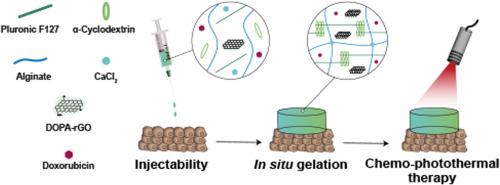Dual-crosslinked injectable in situ forming Alginate/CaCl2/Pluronic F127/α-Cyclodextrin hydrogels incorporating Doxorubicin and graphene-based nanomaterials for cancer chemo-photothermal therapy
IF 4.9
3区 医学
Q1 PHARMACOLOGY & PHARMACY
Journal of Drug Delivery Science and Technology
Pub Date : 2025-09-11
DOI:10.1016/j.jddst.2025.107520
引用次数: 0
Abstract
Injectable in situ forming hydrogels have been emerging due to their capacity to perform the direct delivery of therapeutics into the tumor site with minimal off-target leakage. Particularly, physical crosslinked injectable in situ forming hydrogels are appealing due to their straightforward preparation that exploits the native jointing capabilities of specific polymers/materials. However, the features of these hydrogels (e.g., injectability, degradation, swelling) are strongly pre-determined by the physical interactions available on the selected polymers/materials, occasionally yielding undesired outcomes. Thus, the combination of multiple physical crosslinking cues may allow the preparation of hydrogels with enhanced properties. In this work, a dual-crosslinked injectable in situ forming hydrogel was engineered by combining Pluronic F127/α-Cyclodextrin and Alginate/CaCl2 (i.e., combination of host-guest and electrostatic interactions), being loaded with Doxorubicin (chemotherapeutic drug) and Dopamine-reduced Graphene Oxide (photothermal nano-agent) for application in cancer chemo-photothermal therapy. When compared to the single-crosslinked hydrogels, the dual-crosslinking contributed to the assembly of formulations with suitable injectability and improved degradation and water absorption behaviors. Moreover, the dual-crosslinked hydrogels presented a good photothermal capacity (ΔT ≈ 14 °C), leading to a 1.18-times enhanced Doxorubicin release. In in vitro cell-based studies, the dual-crosslinked hydrogels exhibited an excellent cytocompatibility towards healthy (normal human dermal fibroblasts) and breast cancer (MCF-7) cells. As importantly, the dual-crosslinked hydrogels were able to mediate a chemo-photothermal effect that diminished the cancer cells’ viability to just 23 %. Overall, the developed dual-crosslinked injectable in situ forming hydrogels incorporating Doxorubicin and Dopamine-reduced Graphene Oxide are a promising macroscale system for breast cancer chemo-photothermal therapy.

含有阿霉素和石墨烯纳米材料的双交联可注射原位形成藻酸盐/CaCl2/Pluronic F127/α-环糊精水凝胶用于癌症化学光热治疗
可注射的原位形成水凝胶已经出现,因为它们能够将治疗药物直接输送到肿瘤部位,并且最小的脱靶泄漏。特别是,物理交联可注射原位形成水凝胶具有吸引力,因为它们的制备简单,利用了特定聚合物/材料的天然接合能力。然而,这些水凝胶的特性(例如可注射性、降解性、溶胀性)是由所选聚合物/材料上可用的物理相互作用预先决定的,有时会产生不期望的结果。因此,多种物理交联线索的组合可以制备具有增强性能的水凝胶。本研究将Pluronic F127/α-环糊精和海藻酸盐/CaCl2(即主客体相互作用和静电相互作用的结合)结合在一起,设计了一种双交联可注射原位形成的水凝胶,并负载了阿霉素(化疗药物)和多巴胺还原氧化石墨烯(光热纳米剂),用于癌症化学光热治疗。与单交联水凝胶相比,双交联有助于组装具有合适注射性的配方,并改善降解和吸水行为。此外,双交联水凝胶具有良好的光热容量(ΔT≈14°C),导致阿霉素释放量增加1.18倍。在体外细胞研究中,双交联水凝胶对健康(正常人真皮成纤维细胞)和乳腺癌(MCF-7)细胞表现出良好的细胞相容性。同样重要的是,双交联水凝胶能够介导化学光热效应,将癌细胞的生存能力降低到23%。总之,所开发的含有阿霉素和多巴胺还原氧化石墨烯的双交联可注射原位形成水凝胶是一种很有前途的用于乳腺癌化学光热治疗的宏观系统。
本文章由计算机程序翻译,如有差异,请以英文原文为准。
求助全文
约1分钟内获得全文
求助全文
来源期刊
CiteScore
8.00
自引率
8.00%
发文量
879
审稿时长
94 days
期刊介绍:
The Journal of Drug Delivery Science and Technology is an international journal devoted to drug delivery and pharmaceutical technology. The journal covers all innovative aspects of all pharmaceutical dosage forms and the most advanced research on controlled release, bioavailability and drug absorption, nanomedicines, gene delivery, tissue engineering, etc. Hot topics, related to manufacturing processes and quality control, are also welcomed.

 求助内容:
求助内容: 应助结果提醒方式:
应助结果提醒方式:


